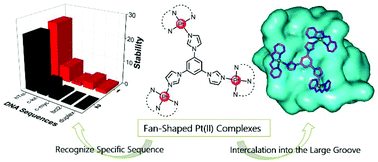Two novel fan-shaped trinuclear Pt(ii) complexes act as G-quadruplex binders and telomerase inhibitors†
Abstract
Two new trinuclear Pt(II) complexes {[Pt(dien)]3(tib)}(NO3)6 (1) and {[Pt(dpa)]3(tib)}(NO3)6 (2) (dien: diethylenetriamine, dpa: bis-(2-pyridylmethyl)amine, tib: 1,3,5-tris(1H-imidazol-1-yl)benzene) have been designed, synthesized, characterized and applied to a series of biochemical studies. We found that both of the Pt(II) complexes exhibited much better selectivity for human telomeric G-quadruplex sequence than promoter G-quadruplexes (c-kit, c-myc, and bcl2) or duplex DNA. Both complexes displayed comparative stability and affinity towards human telomeric G-quadruplex by the studies from surface plasmon resonance, fluorescence resonance energy transfer and polymerase chain reaction stop assays. The circular dichroism indicated that both complexes could induce and stabilize anti-parallel G-quadruplex structures. Molecule docking presented that Pt(II) complex intercalated into the large groove of human telomeric G-quadruplex (PDB ID: 143D). Furthermore, telomeric repeat amplification protocol assays quantitatively evaluated the inhibition of telomerase activity caused by the Pt(II) complexes. The obtained IC50 values of 6.41 ± 0.042 μM and 2.67 ± 0.035 μM for 1 and 2, respectively, exhibited strong telomerase inhibitions. All results suggest that such fan-shaped trinuclear Pt(II) complexes are effective and selective G-quadruplex binders, as well as strong telomerase inhibitors. This study provides insight into the development of human telomeric G-quadruplex targeted anticancer drugs based on the metal complex.



 Please wait while we load your content...
Please wait while we load your content...